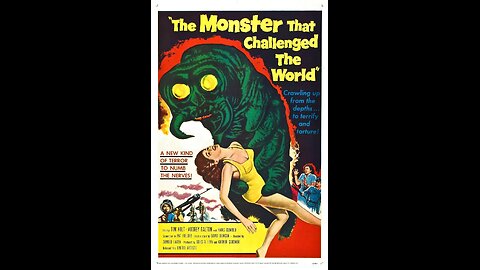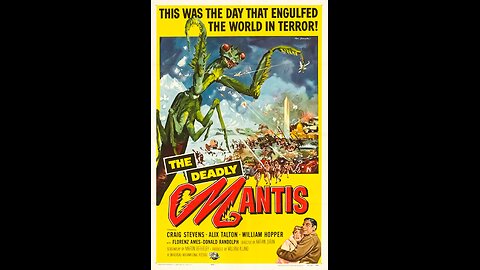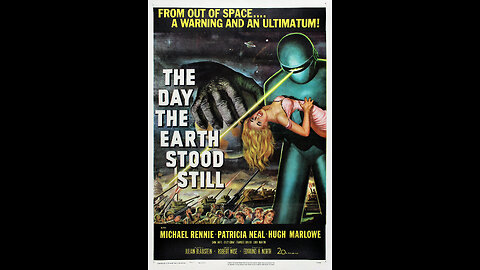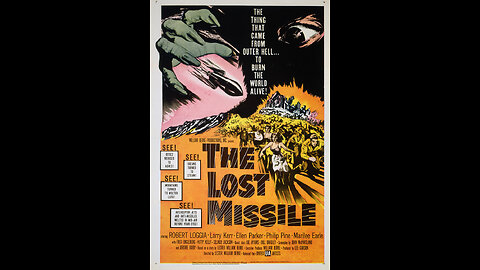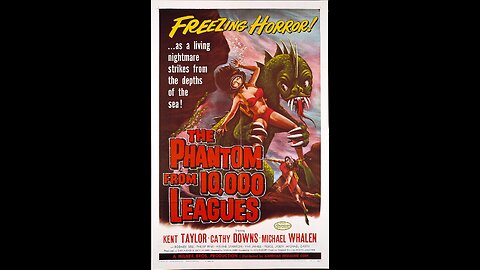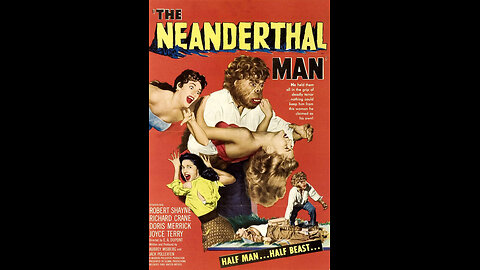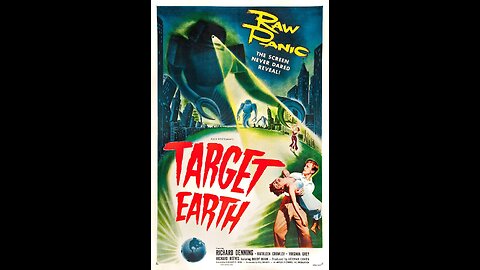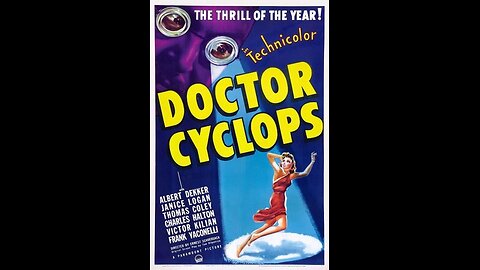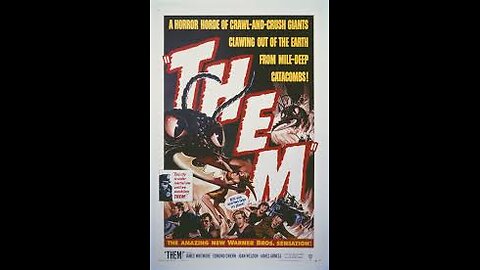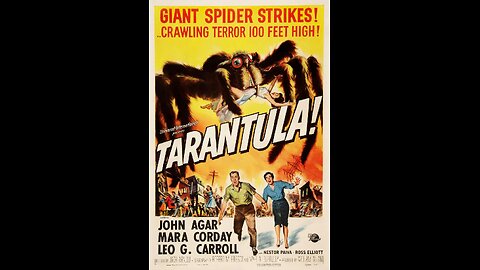
Science Fiction Classics
23 videos
Updated 5 days ago
The Best Science Fiction Movies from the Golden Era of Film.
-
Tarantula (1955) | Directed by Jack Arnold
 Classic Films & Movies ArchiveA series of mysterious deaths in the Arizona desert leads a local doctor and a visiting biochemist to uncover a terrifying experiment gone wrong. A scientist’s nutrient formula, designed to end world hunger, instead causes test animals to grow to monstrous size. When a giant tarantula escapes into the open desert, it begins a deadly trek toward human settlements, forcing authorities into a race to stop the creature before it reaches a populated area. Genre: Science fiction, monster film Director: Jack Arnold Jack Arnold (1916–1992) was an American director best known for his contributions to 1950s science fiction cinema. Starting his career in documentary production, he later shifted to feature films and developed a reputation for clear, efficient storytelling and a strong sense of visual tension. His sci-fi credits include classics such as Creature from the Black Lagoon, The Incredible Shrinking Man, It Came from Outer Space, and This Island Earth (as an uncredited contributor). Arnold’s films are noted for their atmospheric shooting style and allegorical undertones reflecting Cold War anxieties. Star Cast: John Agar as Dr. Matt Hastings Mara Corday as Stephanie Clayton Leo G. Carroll as Prof. Gerald Deemer Nestor Paiva as Sheriff Jack Andrews Ross Elliott as Dr. Paul Lund Hank Patterson as Josh Tarantula was well received by audiences who embraced its suspenseful tone, convincing effects, and straightforward storytelling. Critics considered it a strong entry in the growing wave of giant-creature films of the 1950s. While some viewed the premise as formulaic, many praised the pacing and Jack Arnold’s skilled direction. Over time the film has earned a loyal cult following and is often regarded as one of the better-made giant-monster features of its decade. Fun Facts: The giant tarantula was created using real footage of a live tarantula composited into scenes with actors and miniature sets. A young Clint Eastwood appears uncredited as one of the jet pilots in the film’s climax. The Arizona desert landscapes gave the movie a stark, realistic atmosphere compared to studio-bound sci-fi films of the era. Jack Arnold reused several cast members and crew from his other Universal-International sci-fi productions. The film’s radioactive-growth concept reflected widespread 1950s concerns about nuclear science and unintended consequences. * This Rumble Movie Channel is comprehensively indexed on https://kinoquick.com - find you favourite movies fast & free! * Follow this channel to be notified of daily movie updates.76 views 1 comment
Classic Films & Movies ArchiveA series of mysterious deaths in the Arizona desert leads a local doctor and a visiting biochemist to uncover a terrifying experiment gone wrong. A scientist’s nutrient formula, designed to end world hunger, instead causes test animals to grow to monstrous size. When a giant tarantula escapes into the open desert, it begins a deadly trek toward human settlements, forcing authorities into a race to stop the creature before it reaches a populated area. Genre: Science fiction, monster film Director: Jack Arnold Jack Arnold (1916–1992) was an American director best known for his contributions to 1950s science fiction cinema. Starting his career in documentary production, he later shifted to feature films and developed a reputation for clear, efficient storytelling and a strong sense of visual tension. His sci-fi credits include classics such as Creature from the Black Lagoon, The Incredible Shrinking Man, It Came from Outer Space, and This Island Earth (as an uncredited contributor). Arnold’s films are noted for their atmospheric shooting style and allegorical undertones reflecting Cold War anxieties. Star Cast: John Agar as Dr. Matt Hastings Mara Corday as Stephanie Clayton Leo G. Carroll as Prof. Gerald Deemer Nestor Paiva as Sheriff Jack Andrews Ross Elliott as Dr. Paul Lund Hank Patterson as Josh Tarantula was well received by audiences who embraced its suspenseful tone, convincing effects, and straightforward storytelling. Critics considered it a strong entry in the growing wave of giant-creature films of the 1950s. While some viewed the premise as formulaic, many praised the pacing and Jack Arnold’s skilled direction. Over time the film has earned a loyal cult following and is often regarded as one of the better-made giant-monster features of its decade. Fun Facts: The giant tarantula was created using real footage of a live tarantula composited into scenes with actors and miniature sets. A young Clint Eastwood appears uncredited as one of the jet pilots in the film’s climax. The Arizona desert landscapes gave the movie a stark, realistic atmosphere compared to studio-bound sci-fi films of the era. Jack Arnold reused several cast members and crew from his other Universal-International sci-fi productions. The film’s radioactive-growth concept reflected widespread 1950s concerns about nuclear science and unintended consequences. * This Rumble Movie Channel is comprehensively indexed on https://kinoquick.com - find you favourite movies fast & free! * Follow this channel to be notified of daily movie updates.76 views 1 comment -
The Monster That Challenged the World (1957) | Directed by Arnold Laven
 Classic Films & Movies ArchiveWhen an earthquake releases a nest of giant prehistoric mollusks from the depths of California’s Salton Sea, a series of mysterious deaths alerts the local naval base. As the creatures multiply, military personnel and scientists work urgently to locate their lair and stop an outbreak that threatens the entire region. Genre: Science fiction, monster film Director: Arnold Laven Arnold Laven (1922–2009) was an American director, producer, and screenwriter who worked extensively in film and television. He co-founded Levy-Gardner-Laven Productions, which produced numerous movies and popular TV series. Laven was known for efficient direction across genres, handling westerns, crime dramas, and science fiction with a pragmatic, story-first approach. His film work includes Appointment with a Shadow, Without Warning!, and The Rack. Star Cast: Tim Holt as Lt. Cmdr. John Twillinger Audrey Dalton as Gail MacKenzie Hans Conried as Dr. Jess Rogers Harlan Warde as Lt. Cmdr. Robert “Bob” Brown Casey Adams (Max Showalter) as George MacKenzie Mimi Gibson as Sandy MacKenzie The film received solid responses from audiences who enjoyed its mix of mystery, tension, and creature-feature spectacle. Critics regarded it as an above-average entry in the 1950s monster cycle due to stronger-than-usual acting, a tighter script, and more convincing creature effects. It has since gained a reputation as one of the more polished and effective mid-century monster films. Fun Facts: The creatures were created as large mechanical props with surprisingly detailed movement for the era. The Salton Sea setting added a unique atmospheric backdrop rarely used in 1950s sci-fi cinema. The film is noted for its more serious tone, avoiding camp humor common in other monster movies of the decade. Tim Holt returned to film after several years away, following a long career in westerns. The final confrontation in the laboratory is frequently singled out as one of the film’s most suspenseful sequences. * This Rumble Movie Channel is comprehensively indexed on https://kinoquick.com - find you favourite movies fast & free! * Follow this channel to be notified of daily movie updates.98 views
Classic Films & Movies ArchiveWhen an earthquake releases a nest of giant prehistoric mollusks from the depths of California’s Salton Sea, a series of mysterious deaths alerts the local naval base. As the creatures multiply, military personnel and scientists work urgently to locate their lair and stop an outbreak that threatens the entire region. Genre: Science fiction, monster film Director: Arnold Laven Arnold Laven (1922–2009) was an American director, producer, and screenwriter who worked extensively in film and television. He co-founded Levy-Gardner-Laven Productions, which produced numerous movies and popular TV series. Laven was known for efficient direction across genres, handling westerns, crime dramas, and science fiction with a pragmatic, story-first approach. His film work includes Appointment with a Shadow, Without Warning!, and The Rack. Star Cast: Tim Holt as Lt. Cmdr. John Twillinger Audrey Dalton as Gail MacKenzie Hans Conried as Dr. Jess Rogers Harlan Warde as Lt. Cmdr. Robert “Bob” Brown Casey Adams (Max Showalter) as George MacKenzie Mimi Gibson as Sandy MacKenzie The film received solid responses from audiences who enjoyed its mix of mystery, tension, and creature-feature spectacle. Critics regarded it as an above-average entry in the 1950s monster cycle due to stronger-than-usual acting, a tighter script, and more convincing creature effects. It has since gained a reputation as one of the more polished and effective mid-century monster films. Fun Facts: The creatures were created as large mechanical props with surprisingly detailed movement for the era. The Salton Sea setting added a unique atmospheric backdrop rarely used in 1950s sci-fi cinema. The film is noted for its more serious tone, avoiding camp humor common in other monster movies of the decade. Tim Holt returned to film after several years away, following a long career in westerns. The final confrontation in the laboratory is frequently singled out as one of the film’s most suspenseful sequences. * This Rumble Movie Channel is comprehensively indexed on https://kinoquick.com - find you favourite movies fast & free! * Follow this channel to be notified of daily movie updates.98 views -
The Deadly Mantis (1957) | Directed by Nathan Juran
 Classic Films & Movies ArchiveA massive prehistoric praying mantis is freed from an Arctic ice shelf following a volcanic tremor. The creature begins migrating southward, attacking military outposts, ships, and cities as it moves toward Washington, D.C. A team of scientists and military personnel race to understand the creature’s behavior and stop its destructive path. Genre: Science fiction, monster film Director: Nathan Juran Nathan Juran (1907–2002) was an American film director and art director known for his contributions to mid-century fantasy and science-fiction cinema. He began his career as an art director and won an Academy Award for How Green Was My Valley before moving into directing. Juran became known for genre films such as 20 Million Miles to Earth, Attack of the 50 Foot Woman, and The 7th Voyage of Sinbad, often blending imaginative visuals with adventure-driven storytelling. Star Cast: Craig Stevens as Col. Joe Parkman William Hopper as Dr. Ned Jackson Alix Talton as Marge Blaine Pat Conway as Lt. Eddie Donald Randolph as Dr. Parkman Florenz Ames as Dr. Canfield The film received mixed reviews upon release. Audiences enjoyed its classic giant-monster thrills and energetic pacing, while critics often viewed it as formulaic within the 1950s creature-feature trend. Over time, it has become a cult favorite among fans of vintage sci-fi and monster films, noted for its practical effects and representative place in Cold War-era genre cinema. Fun Facts: The titular mantis was a large-scale practical model combined with footage of a real praying mantis for some scenes. Stock footage from U.S. military archives was heavily used, a common technique in 1950s creature films to increase scale without raising budgets. The film’s promotional materials referenced real scientific speculation about prehistoric creatures surviving in ice, tapping into public fascination with polar exploration. Some scenes were shot inside the authentic Northrop Aircraft facilities to add realism. The Chicago fog-shrouded sequence is often cited as one of the film’s most atmospheric moments. * This Rumble Movie Channel is comprehensively indexed on https://kinoquick.com - find you favourite movies fast & free! * Follow this channel to be notified of daily movie updates.90 views
Classic Films & Movies ArchiveA massive prehistoric praying mantis is freed from an Arctic ice shelf following a volcanic tremor. The creature begins migrating southward, attacking military outposts, ships, and cities as it moves toward Washington, D.C. A team of scientists and military personnel race to understand the creature’s behavior and stop its destructive path. Genre: Science fiction, monster film Director: Nathan Juran Nathan Juran (1907–2002) was an American film director and art director known for his contributions to mid-century fantasy and science-fiction cinema. He began his career as an art director and won an Academy Award for How Green Was My Valley before moving into directing. Juran became known for genre films such as 20 Million Miles to Earth, Attack of the 50 Foot Woman, and The 7th Voyage of Sinbad, often blending imaginative visuals with adventure-driven storytelling. Star Cast: Craig Stevens as Col. Joe Parkman William Hopper as Dr. Ned Jackson Alix Talton as Marge Blaine Pat Conway as Lt. Eddie Donald Randolph as Dr. Parkman Florenz Ames as Dr. Canfield The film received mixed reviews upon release. Audiences enjoyed its classic giant-monster thrills and energetic pacing, while critics often viewed it as formulaic within the 1950s creature-feature trend. Over time, it has become a cult favorite among fans of vintage sci-fi and monster films, noted for its practical effects and representative place in Cold War-era genre cinema. Fun Facts: The titular mantis was a large-scale practical model combined with footage of a real praying mantis for some scenes. Stock footage from U.S. military archives was heavily used, a common technique in 1950s creature films to increase scale without raising budgets. The film’s promotional materials referenced real scientific speculation about prehistoric creatures surviving in ice, tapping into public fascination with polar exploration. Some scenes were shot inside the authentic Northrop Aircraft facilities to add realism. The Chicago fog-shrouded sequence is often cited as one of the film’s most atmospheric moments. * This Rumble Movie Channel is comprehensively indexed on https://kinoquick.com - find you favourite movies fast & free! * Follow this channel to be notified of daily movie updates.90 views -
The Day the Earth Stood Still (1951) | Directed by Robert Wise
 Classic Films & Movies ArchiveA mysterious humanoid alien named Klaatu arrives in Washington, D.C., accompanied by a powerful robot called Gort. Klaatu brings an urgent message for all humankind, but fear and misunderstanding complicate his mission. As tensions escalate, he seeks the help of an ordinary widow and her son to deliver a warning that could determine Earth’s survival. Genre: Science fiction, drama Director: Robert Wise Robert Wise (1914–2005) was an American director, producer, and editor known for his versatility and precision across genres. Before becoming a director, he edited major films such as Citizen Kane. He went on to direct classics including West Side Story, The Sound of Music, The Haunting, and The Andromeda Strain. Wise was celebrated for his craftsmanship, storytelling clarity, and ability to blend technical skill with emotional depth. Star Cast: Michael Rennie as Klaatu Patricia Neal as Helen Benson Hugh Marlowe as Tom Stevens Sam Jaffe as Professor Jacob Barnhardt Billy Gray as Bobby Benson Lock Martin as Gort (the robot) Upon release, the film was widely praised for its intelligent script, atmospheric direction, and thought-provoking themes. Critics admired its balanced tone, its message about peace during the tense early years of the Cold War, and its pioneering approach to science fiction. It has since become a landmark of the genre, often cited as one of the greatest sci-fi films ever made. Fun Facts: The robot Gort’s suit was made of foam rubber and required two versions, one for standing scenes and another for action shots. The film’s iconic phrase “Klaatu barada nikto” has become one of cinema’s most enduring sci-fi lines. Albert Einstein and other prominent scientists reportedly admired the film’s pacifist message. Bernard Herrmann, known for his work with Hitchcock, created the eerie electronic score using two theremins, helping set the tone for future sci-fi soundscapes. The film was preserved in the National Film Registry for its cultural and historical significance. * This Rumble Movie Channel is comprehensively indexed on https://kinoquick.com - find you favourite movies fast & free! * Follow this channel to be notified of daily movie updates.115 views
Classic Films & Movies ArchiveA mysterious humanoid alien named Klaatu arrives in Washington, D.C., accompanied by a powerful robot called Gort. Klaatu brings an urgent message for all humankind, but fear and misunderstanding complicate his mission. As tensions escalate, he seeks the help of an ordinary widow and her son to deliver a warning that could determine Earth’s survival. Genre: Science fiction, drama Director: Robert Wise Robert Wise (1914–2005) was an American director, producer, and editor known for his versatility and precision across genres. Before becoming a director, he edited major films such as Citizen Kane. He went on to direct classics including West Side Story, The Sound of Music, The Haunting, and The Andromeda Strain. Wise was celebrated for his craftsmanship, storytelling clarity, and ability to blend technical skill with emotional depth. Star Cast: Michael Rennie as Klaatu Patricia Neal as Helen Benson Hugh Marlowe as Tom Stevens Sam Jaffe as Professor Jacob Barnhardt Billy Gray as Bobby Benson Lock Martin as Gort (the robot) Upon release, the film was widely praised for its intelligent script, atmospheric direction, and thought-provoking themes. Critics admired its balanced tone, its message about peace during the tense early years of the Cold War, and its pioneering approach to science fiction. It has since become a landmark of the genre, often cited as one of the greatest sci-fi films ever made. Fun Facts: The robot Gort’s suit was made of foam rubber and required two versions, one for standing scenes and another for action shots. The film’s iconic phrase “Klaatu barada nikto” has become one of cinema’s most enduring sci-fi lines. Albert Einstein and other prominent scientists reportedly admired the film’s pacifist message. Bernard Herrmann, known for his work with Hitchcock, created the eerie electronic score using two theremins, helping set the tone for future sci-fi soundscapes. The film was preserved in the National Film Registry for its cultural and historical significance. * This Rumble Movie Channel is comprehensively indexed on https://kinoquick.com - find you favourite movies fast & free! * Follow this channel to be notified of daily movie updates.115 views -
The Lost Missile (1956) | Directed by William Berke
 Classic Films & Movies ArchiveThis science fiction film centers on a mysterious missile from space that enters Earth’s atmosphere and begins orbiting the planet at low altitude, emitting destructive heat rays that incinerate everything in its path. As cities are destroyed and panic spreads, scientists and military forces race against time to find a way to stop the deadly weapon before it annihilates civilization. Genre: Science Fiction / Thriller Director: William Berke William A. Berke (1903–1958) was an American film director and producer best known for his work in B-movies, westerns, and crime thrillers. He directed and produced a large number of low-budget films during the 1930s through the 1950s, with a reputation for efficiency and speed. Although rarely celebrated for artistry, his films were consistent staples of mid-century American cinema. The Lost Missile is among his final directorial works, combining Cold War anxieties with science fiction spectacle. Star Cast: Robert Loggia as Dr. David Loring Ellen Parker as Joan Wood Larry Kerr as Col. Joe Freed Phillip Pine as Dr. Kurt Steinhauer Kitty Kelly as Mrs. Mabel Colter Selena Royle as Mrs. Loring The film was a modest box-office success, appealing to audiences during the height of Cold War tensions when fears of nuclear war and space-age weaponry were at their peak. Critics noted its use of stock footage and low budget, but many viewers found it tense and thought-provoking. Over time, it has been remembered as a quintessential example of 1950s science fiction that reflected the era’s anxieties about technology and global destruction. Fun Facts: The film reused large amounts of stock footage, particularly military and civil defense material, to stretch its budget and create a sense of scale. Robert Loggia, in one of his earliest leading roles, later became a respected actor with a career spanning six decades, including Scarface (1983) and Big (1988). The movie was produced independently and distributed by United Artists, reflecting the growing trend of low-budget sci-fi films aimed at drive-in theaters. The plot tapped into contemporary fears of Sputnik and space-based weapons, making it resonate strongly with 1950s audiences. Despite its low budget, the film has remained a cult favorite among fans of Cold War-era science fiction. * This Rumble Movie Channel is comprehensively indexed on https://kinoquick.com - find you favourite movies fast & free! * Follow this channel to be notified of daily movie updates.318 views
Classic Films & Movies ArchiveThis science fiction film centers on a mysterious missile from space that enters Earth’s atmosphere and begins orbiting the planet at low altitude, emitting destructive heat rays that incinerate everything in its path. As cities are destroyed and panic spreads, scientists and military forces race against time to find a way to stop the deadly weapon before it annihilates civilization. Genre: Science Fiction / Thriller Director: William Berke William A. Berke (1903–1958) was an American film director and producer best known for his work in B-movies, westerns, and crime thrillers. He directed and produced a large number of low-budget films during the 1930s through the 1950s, with a reputation for efficiency and speed. Although rarely celebrated for artistry, his films were consistent staples of mid-century American cinema. The Lost Missile is among his final directorial works, combining Cold War anxieties with science fiction spectacle. Star Cast: Robert Loggia as Dr. David Loring Ellen Parker as Joan Wood Larry Kerr as Col. Joe Freed Phillip Pine as Dr. Kurt Steinhauer Kitty Kelly as Mrs. Mabel Colter Selena Royle as Mrs. Loring The film was a modest box-office success, appealing to audiences during the height of Cold War tensions when fears of nuclear war and space-age weaponry were at their peak. Critics noted its use of stock footage and low budget, but many viewers found it tense and thought-provoking. Over time, it has been remembered as a quintessential example of 1950s science fiction that reflected the era’s anxieties about technology and global destruction. Fun Facts: The film reused large amounts of stock footage, particularly military and civil defense material, to stretch its budget and create a sense of scale. Robert Loggia, in one of his earliest leading roles, later became a respected actor with a career spanning six decades, including Scarface (1983) and Big (1988). The movie was produced independently and distributed by United Artists, reflecting the growing trend of low-budget sci-fi films aimed at drive-in theaters. The plot tapped into contemporary fears of Sputnik and space-based weapons, making it resonate strongly with 1950s audiences. Despite its low budget, the film has remained a cult favorite among fans of Cold War-era science fiction. * This Rumble Movie Channel is comprehensively indexed on https://kinoquick.com - find you favourite movies fast & free! * Follow this channel to be notified of daily movie updates.318 views -
The Phantom from 10,000 Leagues (1955) | Directed by Dan Milner
 Classic Films & Movies ArchiveThe Phantom from 10,000 Leagues is a low-budget science fiction film about a mysterious sea creature lurking off the California coast. As bodies begin to surface, scientists and government agents investigate, uncovering a plot tied to radiation experiments and a deadly undersea monster. Genre: Science fiction / Horror Director: Dan Milner Dan Milner (1901–1970) was an American director and editor who primarily worked on low-budget films during the 1940s and 1950s. His output included westerns, horror, and science fiction, often made quickly and inexpensively for smaller studios. While never a mainstream Hollywood figure, Milner’s films are remembered as part of the wave of B-movies that defined mid-century drive-in culture. Star Cast: Kent Taylor as Dr. Ted Stevens Cathy Downs as Lois King Michael Whalen as George Thomas Phillip Pine as William Grant Helene Stanton as Wanda Rodney Bell as Fred The film was released as part of the booming 1950s science fiction craze, often paired on double bills with other creature features. Critics at the time were dismissive, pointing out the cheap effects, wooden dialogue, and predictable plot. However, the movie has since gained a reputation among fans of campy B-movies and remains a cult curiosity from the era. Fun Facts: Released in 1955, the same year as another low-budget creature flick, The Beast with a Million Eyes, with which it was often compared. The monster costume was criticized for its clumsiness but has become iconic among B-movie enthusiasts. Cathy Downs, who plays Lois King, was best known for her earlier role as Clementine in the classic western My Darling Clementine (1946). The film’s title promised deep-sea thrills, but most of the action takes place near the shore in shallow water. Like many B-films of the era, it was rushed into production to capitalize on the popularity of Creature from the Black Lagoon (1954). * This Rumble Movie Channel is comprehensively indexed on https://kinoquick.com - find you favourite movies fast & free! * Follow this channel to be notified of daily movie updates.229 views 1 comment
Classic Films & Movies ArchiveThe Phantom from 10,000 Leagues is a low-budget science fiction film about a mysterious sea creature lurking off the California coast. As bodies begin to surface, scientists and government agents investigate, uncovering a plot tied to radiation experiments and a deadly undersea monster. Genre: Science fiction / Horror Director: Dan Milner Dan Milner (1901–1970) was an American director and editor who primarily worked on low-budget films during the 1940s and 1950s. His output included westerns, horror, and science fiction, often made quickly and inexpensively for smaller studios. While never a mainstream Hollywood figure, Milner’s films are remembered as part of the wave of B-movies that defined mid-century drive-in culture. Star Cast: Kent Taylor as Dr. Ted Stevens Cathy Downs as Lois King Michael Whalen as George Thomas Phillip Pine as William Grant Helene Stanton as Wanda Rodney Bell as Fred The film was released as part of the booming 1950s science fiction craze, often paired on double bills with other creature features. Critics at the time were dismissive, pointing out the cheap effects, wooden dialogue, and predictable plot. However, the movie has since gained a reputation among fans of campy B-movies and remains a cult curiosity from the era. Fun Facts: Released in 1955, the same year as another low-budget creature flick, The Beast with a Million Eyes, with which it was often compared. The monster costume was criticized for its clumsiness but has become iconic among B-movie enthusiasts. Cathy Downs, who plays Lois King, was best known for her earlier role as Clementine in the classic western My Darling Clementine (1946). The film’s title promised deep-sea thrills, but most of the action takes place near the shore in shallow water. Like many B-films of the era, it was rushed into production to capitalize on the popularity of Creature from the Black Lagoon (1954). * This Rumble Movie Channel is comprehensively indexed on https://kinoquick.com - find you favourite movies fast & free! * Follow this channel to be notified of daily movie updates.229 views 1 comment -
The Neanderthal Man (1953) | Directed by Ewald André Dupont
 Classic Films & Movies ArchiveA scientist's reckless experiment transforms him into a savage throwback to prehistoric man in this low-budget science fiction thriller. The story blends mad science with primal terror as a small-town community grapples with the consequences of unchecked ambition and evolution reversed. Genre: Science fiction, horror Director: Ewald André Dupont Ewald André Dupont was a German-born filmmaker who began his career during the silent era and later transitioned to work in Britain and the United States. He is best known for his early influential film *Varieté* (1925), but after moving to Hollywood, his career became less prestigious, often working on B-movies and genre films. *The Neanderthal Man* reflects his later-period work within low-budget American cinema. Star cast: * Robert Shayne as Professor Clifford Groves * Joyce Terry as Ruth Marshall * Richard Crane as Dr. Ross Harkness * Doris Merrick as Nola Mason * Beverly Garland as Jan Groves * Robert Long as Police Chief Bell * Tandra Quinn as Celia * Frank Gerstle as Hoxie The film was met with largely negative reviews upon release, criticized for its implausible science, wooden acting, and poor makeup effects. Even among 1950s sci-fi enthusiasts, it was seen as a lesser entry, although it later gained a cult following among fans of campy genre fare. Fun facts: * The titular Neanderthal makeup was widely mocked at the time and remains a source of fascination for cult movie fans. * Beverly Garland, later known for her TV work, made one of her early genre appearances here. * The movie's themes of devolution and transformation echo other popular fears of the atomic age, reflecting anxieties about science gone awry. * Despite the film's title, the creature portrayed doesn’t resemble an actual Neanderthal but rather a generic “caveman” stereotype. * This Rumble Movie Channel is comprehensively indexed on https://kinoquick.com - find you favourite movies fast & free! * Follow this channel to be notified of daily movie updates.310 views
Classic Films & Movies ArchiveA scientist's reckless experiment transforms him into a savage throwback to prehistoric man in this low-budget science fiction thriller. The story blends mad science with primal terror as a small-town community grapples with the consequences of unchecked ambition and evolution reversed. Genre: Science fiction, horror Director: Ewald André Dupont Ewald André Dupont was a German-born filmmaker who began his career during the silent era and later transitioned to work in Britain and the United States. He is best known for his early influential film *Varieté* (1925), but after moving to Hollywood, his career became less prestigious, often working on B-movies and genre films. *The Neanderthal Man* reflects his later-period work within low-budget American cinema. Star cast: * Robert Shayne as Professor Clifford Groves * Joyce Terry as Ruth Marshall * Richard Crane as Dr. Ross Harkness * Doris Merrick as Nola Mason * Beverly Garland as Jan Groves * Robert Long as Police Chief Bell * Tandra Quinn as Celia * Frank Gerstle as Hoxie The film was met with largely negative reviews upon release, criticized for its implausible science, wooden acting, and poor makeup effects. Even among 1950s sci-fi enthusiasts, it was seen as a lesser entry, although it later gained a cult following among fans of campy genre fare. Fun facts: * The titular Neanderthal makeup was widely mocked at the time and remains a source of fascination for cult movie fans. * Beverly Garland, later known for her TV work, made one of her early genre appearances here. * The movie's themes of devolution and transformation echo other popular fears of the atomic age, reflecting anxieties about science gone awry. * Despite the film's title, the creature portrayed doesn’t resemble an actual Neanderthal but rather a generic “caveman” stereotype. * This Rumble Movie Channel is comprehensively indexed on https://kinoquick.com - find you favourite movies fast & free! * Follow this channel to be notified of daily movie updates.310 views -
Target Earth (1954) | Directed by Sherman A. Rose
 Classic Films & Movies ArchiveTarget Earth is a low-budget science fiction thriller that tells the story of a small group of people trapped in a deserted American city after a mysterious evacuation. As they try to understand why the city has been abandoned, they discover it has been invaded by giant robots from another planet. With the military preparing a counterstrike and time running out, the survivors must find a way to escape before the machines destroy them all. Genre: Science Fiction / Thriller Director: Sherman A. Rose Sherman A. Rose was a film editor-turned-director whose career was mostly centered around low-budget productions during the 1950s. Though his directorial credits were limited, he is best known for Target Earth, which stands out as his most notable work. Rose primarily worked behind the scenes in Hollywood and later transitioned into television editing. Star Cast: * Richard Denning as Frank Brooks * Kathleen Crowley as Nora King * Virginia Grey as Vicki Harris * Richard Reeves as Jim Wilson * Robert Roark as Charles Otis * Whit Bissell as Tom At the time of its release, Target Earth was received as a modest but intriguing entry in the wave of post-war science fiction films. While critics pointed out its budgetary limitations and stiff performances, the film gained attention for its eerie, atmospheric shots of an empty city and its mechanical invaders. It has since earned a cult following among fans of 1950s sci-fi for its earnest approach and early depiction of robot invaders. Fun Facts: * The film was shot in just seven days, primarily using downtown Los Angeles in the early morning to simulate the abandoned cityscape. * The invading robots were created using a single costume worn by a stuntman, filmed from various angles to give the illusion of multiple machines. * Whit Bissell, who appears in a supporting role, became a familiar face in many genre films and television shows of the era. * Target Earth is considered one of the earliest films to feature a robot invasion of Earth, predating more elaborate efforts later in the decade. * This Rumble Movie Channel is comprehensively indexed on https://kinoquick.com - find you favourite movies fast & free! * Follow this channel to be notified of daily movie updates.438 views
Classic Films & Movies ArchiveTarget Earth is a low-budget science fiction thriller that tells the story of a small group of people trapped in a deserted American city after a mysterious evacuation. As they try to understand why the city has been abandoned, they discover it has been invaded by giant robots from another planet. With the military preparing a counterstrike and time running out, the survivors must find a way to escape before the machines destroy them all. Genre: Science Fiction / Thriller Director: Sherman A. Rose Sherman A. Rose was a film editor-turned-director whose career was mostly centered around low-budget productions during the 1950s. Though his directorial credits were limited, he is best known for Target Earth, which stands out as his most notable work. Rose primarily worked behind the scenes in Hollywood and later transitioned into television editing. Star Cast: * Richard Denning as Frank Brooks * Kathleen Crowley as Nora King * Virginia Grey as Vicki Harris * Richard Reeves as Jim Wilson * Robert Roark as Charles Otis * Whit Bissell as Tom At the time of its release, Target Earth was received as a modest but intriguing entry in the wave of post-war science fiction films. While critics pointed out its budgetary limitations and stiff performances, the film gained attention for its eerie, atmospheric shots of an empty city and its mechanical invaders. It has since earned a cult following among fans of 1950s sci-fi for its earnest approach and early depiction of robot invaders. Fun Facts: * The film was shot in just seven days, primarily using downtown Los Angeles in the early morning to simulate the abandoned cityscape. * The invading robots were created using a single costume worn by a stuntman, filmed from various angles to give the illusion of multiple machines. * Whit Bissell, who appears in a supporting role, became a familiar face in many genre films and television shows of the era. * Target Earth is considered one of the earliest films to feature a robot invasion of Earth, predating more elaborate efforts later in the decade. * This Rumble Movie Channel is comprehensively indexed on https://kinoquick.com - find you favourite movies fast & free! * Follow this channel to be notified of daily movie updates.438 views -
Dr. Cyclops (1940) | Directed by Ernest B. Schoedsack
 Classic Films & Movies ArchiveIn a remote jungle laboratory, a brilliant but unhinged scientist discovers a method to shrink living creatures, including humans, to a fraction of their size. When fellow researchers arrive to investigate his increasingly erratic behavior, they become test subjects in his terrifying experiments, forced to survive in a hostile, oversized world where even a house cat is a deadly predator. Genre: Science Fiction / Horror / Adventure Director: Ernest B. Schoedsack Ernest B. Schoedsack was an American filmmaker best known for co-directing the legendary *King Kong* (1933) alongside Merian C. Cooper. With a background in documentary filmmaking and exploration, Schoedsack had a flair for combining exotic locales with imaginative fantasy, often pushing the boundaries of visual effects in early cinema. His films frequently featured daring adventurers and monstrous threats, blending realism with the fantastic. Star Cast: * Albert Dekker as Dr. Alexander Thorkel * Thomas Coley as Bill Stockton * Janice Logan as Dr. Mary Robinson * Charles Halton as Dr. Rupert Bulfinch * Victor Kilian as Steve Baker * Frank Yaconelli as Pedro Dr. Cyclops was one of the earliest science fiction films to be shot in Technicolor and received attention for its vibrant visuals and impressive special effects. Contemporary critics praised the film's color cinematography and creative set design, although some found the plot simplistic. Over time, it has become a cult favorite for fans of vintage sci-fi, appreciated for its technical innovation and bizarre premise. Fun Facts: * Dr. Cyclops was the first American science fiction film shot entirely in three-strip Technicolor, a bold move at the time for a genre often relegated to black-and-white. * The film received an Academy Award nomination for Best Visual Effects. * The special effects team used oversized props and composite photography to convincingly depict the miniature humans navigating a giant world. * Albert Dekker’s menacing portrayal of Dr. Thorkel helped establish the “mad scientist” archetype in American science fiction cinema. * This Rumble Movie Channel is comprehensively indexed on https://kinoquick.com - find you favourite movies fast & free! * Follow this channel to be notified of daily movie updates.434 views
Classic Films & Movies ArchiveIn a remote jungle laboratory, a brilliant but unhinged scientist discovers a method to shrink living creatures, including humans, to a fraction of their size. When fellow researchers arrive to investigate his increasingly erratic behavior, they become test subjects in his terrifying experiments, forced to survive in a hostile, oversized world where even a house cat is a deadly predator. Genre: Science Fiction / Horror / Adventure Director: Ernest B. Schoedsack Ernest B. Schoedsack was an American filmmaker best known for co-directing the legendary *King Kong* (1933) alongside Merian C. Cooper. With a background in documentary filmmaking and exploration, Schoedsack had a flair for combining exotic locales with imaginative fantasy, often pushing the boundaries of visual effects in early cinema. His films frequently featured daring adventurers and monstrous threats, blending realism with the fantastic. Star Cast: * Albert Dekker as Dr. Alexander Thorkel * Thomas Coley as Bill Stockton * Janice Logan as Dr. Mary Robinson * Charles Halton as Dr. Rupert Bulfinch * Victor Kilian as Steve Baker * Frank Yaconelli as Pedro Dr. Cyclops was one of the earliest science fiction films to be shot in Technicolor and received attention for its vibrant visuals and impressive special effects. Contemporary critics praised the film's color cinematography and creative set design, although some found the plot simplistic. Over time, it has become a cult favorite for fans of vintage sci-fi, appreciated for its technical innovation and bizarre premise. Fun Facts: * Dr. Cyclops was the first American science fiction film shot entirely in three-strip Technicolor, a bold move at the time for a genre often relegated to black-and-white. * The film received an Academy Award nomination for Best Visual Effects. * The special effects team used oversized props and composite photography to convincingly depict the miniature humans navigating a giant world. * Albert Dekker’s menacing portrayal of Dr. Thorkel helped establish the “mad scientist” archetype in American science fiction cinema. * This Rumble Movie Channel is comprehensively indexed on https://kinoquick.com - find you favourite movies fast & free! * Follow this channel to be notified of daily movie updates.434 views -
Them! (1954) | Directed by Gordon Douglas
 Classic Films & Movies ArchiveIn the New Mexico desert, police sergeant Ben Peterson discovers a young girl in shock near a destroyed trailer. Investigations reveal that atomic tests have caused common ants to mutate into giant, aggressive creatures threatening humanity. As the ants spread, authorities race against time to locate and exterminate the colonies before they overrun civilization. Genre: Science Fiction, Horror Director: Gordon Douglas Gordon Douglas (1907–1993) was an American film director known for his versatility across various genres, including westerns, crime dramas, and science fiction. His career spanned several decades, during which he directed notable films such as "The Detective" (1968) and "Stagecoach" (1966). Star Cast: - James Whitmore as Sgt. Ben Peterson - Edmund Gwenn as Dr. Harold Medford - Joan Weldon as Dr. Patricia Medford - James Arness as FBI Agent Robert Graham - Onslow Stevens as General O'Brien - Sean McClory as Major Kibbee - Chris Drake as Trooper Ed Blackburn - Sandy Descher as Ellinson Girl - Fess Parker as Alan Crotty - Olin Howland as Jensen (uncredited) Upon its release, "Them!" was praised for its suspenseful narrative and special effects, earning an Academy Award nomination for Best Special Effects. It has since become a classic in the science fiction genre, noted for its commentary on the fears surrounding nuclear technology in the 1950s. Fun Facts: - "Them!" was originally planned to be filmed in color and 3D; however, due to technical issues, it was shot in black and white. - The film is one of the first "nuclear monster" movies, initiating a trend of science fiction films featuring creatures mutated by atomic radiation. - A young Leonard Nimoy makes an uncredited appearance as an Air Force sergeant, years before gaining fame as Spock in "Star Trek."643 views
Classic Films & Movies ArchiveIn the New Mexico desert, police sergeant Ben Peterson discovers a young girl in shock near a destroyed trailer. Investigations reveal that atomic tests have caused common ants to mutate into giant, aggressive creatures threatening humanity. As the ants spread, authorities race against time to locate and exterminate the colonies before they overrun civilization. Genre: Science Fiction, Horror Director: Gordon Douglas Gordon Douglas (1907–1993) was an American film director known for his versatility across various genres, including westerns, crime dramas, and science fiction. His career spanned several decades, during which he directed notable films such as "The Detective" (1968) and "Stagecoach" (1966). Star Cast: - James Whitmore as Sgt. Ben Peterson - Edmund Gwenn as Dr. Harold Medford - Joan Weldon as Dr. Patricia Medford - James Arness as FBI Agent Robert Graham - Onslow Stevens as General O'Brien - Sean McClory as Major Kibbee - Chris Drake as Trooper Ed Blackburn - Sandy Descher as Ellinson Girl - Fess Parker as Alan Crotty - Olin Howland as Jensen (uncredited) Upon its release, "Them!" was praised for its suspenseful narrative and special effects, earning an Academy Award nomination for Best Special Effects. It has since become a classic in the science fiction genre, noted for its commentary on the fears surrounding nuclear technology in the 1950s. Fun Facts: - "Them!" was originally planned to be filmed in color and 3D; however, due to technical issues, it was shot in black and white. - The film is one of the first "nuclear monster" movies, initiating a trend of science fiction films featuring creatures mutated by atomic radiation. - A young Leonard Nimoy makes an uncredited appearance as an Air Force sergeant, years before gaining fame as Spock in "Star Trek."643 views
